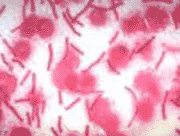|
 |
| Anthrax bacterium under the microscope |
What is anthrax?
Anthrax is a colorless, odorless, tasteless bacterium that protects itself from sunlight, heat and disinfectant by forming a protective coat. With this coat, the bacterium is called a "spore." The spores are so small that even an infectious dose - between 8,000 and 10,000 spores - is smaller than a speck of dust.
If inhaled, anthrax spores can germinate and lead to infection within one to 60 days. This is pulmonary anthrax, which usually causes death.
Less lethal forms include cutaneous infections, which occur if anthrax spores come in contact with a cut or other opening in the skin.
Another form of anthrax develops in the intestine of those who eat improperly cooked meat of animals that have been infected with anthrax.
Is anthrax contagious?
Anthrax does not spread from person to person. It is a "one-time agent" - to catch it a person must come directly in contact with the bacterium.
What are the symptoms of anthrax?
Symptoms of pulmonary anthrax are very similar to the flu, which can make an initial diagnosis somewhat difficult. However, in light of recent events many doctors have a heightened awareness of the possibility, and are therefore more likely to diagnose it.
Symptoms of the disease vary depending on how the disease was contracted, but usually occur within seven days. The Centers for Disease Control list the following:
Cutaneous: Most (about 95 percent) anthrax infections occur when the bacterium enters a cut or abrasion on the skin, such as when handling contaminated wool, hides, leather or hair products (especially goat hair) of infected animals. Skin infection begins as a raised itchy bump that is dark in color and resembles an insect bite but within 1-2 days develops into a vesicle and then a painless ulcer, usually 1-3 centimeters in diameter, with a characteristic black area in the center. Lymph glands in the adjacent area may swell. About 20 percent of untreated cases of cutaneous anthrax will result in death. Deaths are rare with appropriate therapy.
Inhalation: Initial symptoms may resemble a common cold. After several days, the symptoms may progress to severe breathing problems and shock. Inhalation anthrax is usually fatal.
Intestinal: The intestinal disease form of anthrax may follow the consumption of contaminated meat and is characterized by an acute inflammation of the intestinal tract. Initial signs of nausea, loss of appetite, vomiting, fever are followed by abdominal pain, vomiting of blood, and severe diarrhea. Intestinal anthrax results in death in 25 percent to 60 percent of cases.
What is the treatment for anthrax?
Antibiotics, including Ciprofloxacin (sometimes shortened to "cipro") and penicillin can be effective if administered after infection. For pulmonary anthrax, the drugs must be administered very soon after infection.
(Agencies)
|
什么是炭疽熱?
炭疽熱是一種無色、無味的細菌。炭疽熱桿菌會形成孢子結(jié)構(gòu),其孢囊可以保護細菌本身不受光、熱和殺毒劑的影響。炭疽熱的孢子體積非常小,通常8000 至10000個孢子達到感染濃度,這么多數(shù)量的孢子體積要比一粒灰塵的體積還要小。
如果吸入炭疽熱細菌,其孢子會在生物體內(nèi)迅速增生,生物體將在1天至60天內(nèi)被感染。這種呼吸性炭疽熱細菌的感染通常是致命的。
另一種炭疽熱是皮膚性炭疽熱。這種炭疽熱是由于炭疽熱孢子通過傷口裸露的皮膚進入感染對象體內(nèi),它通常沒有生命危險。
最后一種炭疽熱是腸胃性炭疽熱。食用感染了炭疽熱桿菌,且沒有煮熟的肉類是此類炭疽熱的主要傳播渠道。
炭疽熱會傳染嗎?
人和人之間并不會互相傳染炭疽熱。炭疽熱必須是人們直接接觸了這種病菌,才有可能被感染。
炭疽熱的癥狀
肺部炭疽熱的癥狀與流感很相似,所以由初期癥狀很難確診。但是許多醫(yī)生認為最近出現(xiàn)的幾例病例在癥狀上很有可能就是炭疽熱。
由于傳染方式的不同,炭疽熱也呈現(xiàn)各種不同的癥狀,但是通常炭疽病菌的潛伏期為7天。以下是疾病控制中心列出的各種炭疽熱的癥狀:
皮膚性炭疽熱:大約95%的炭疽熱患者是通過皮膚接觸感染病菌的,炭疽熱桿菌通過被切開或磨損的皮膚進入生物體內(nèi)。感染初期生物體將出現(xiàn)有癢感的腫塊,癢的程度要超過一般的蚊蟲叮咬,隨后將發(fā)展成1-3厘米的無痛感皮膚潰瘍,潰瘍的中央將形成炭疽熱感染所特有的黑色腐肉。
炭疽熱桿菌會通過壞死的皮膚和肌肉組織滲入血液循環(huán)系統(tǒng),患者將出現(xiàn)渾身乏力,出虛汗、發(fā)燒、打冷顫、蒼白、頭痛、虛脫等癥狀,嚴重時還會出現(xiàn)休克。如果不采取及時的治療措施,皮膚性炭疽熱還是會導致死亡,死亡率為20%。
·呼吸性炭疽熱:炭疽熱桿菌通過空氣傳播,進入生物的呼吸系統(tǒng)和肺部,再進入血液循環(huán)。患者會很快出現(xiàn)感冒或肺炎的癥狀,呼吸困難,有時還會伴隨腦膜炎的發(fā)生。
這種類型的炭疽熱感染概率非常低,但后果最為嚴重,患者可能會在不到48小時內(nèi)喪生。其臨床癥狀主要有發(fā)燒、全身不適、頭痛、呼吸急促、咳嗽、鼻喉充血以及關(guān)節(jié)僵硬疼痛等。
·腸道性炭疽熱:食用感染了炭疽熱桿菌,且沒有煮熟的肉類是此類炭疽熱的主要傳播渠道。
腸道性炭疽熱因其感染部位的不同又可分為口腔-咽喉型和腹部型。前者屬于上消化系統(tǒng)感染,患者的口腔和食道會出現(xiàn)潰瘍,然后出現(xiàn)局部淋巴結(jié)腫大、敗血癥等癥狀。患者會感覺呼吸、吞咽困難。
而后者則是下消化系統(tǒng)感染,初期癥狀是腸胃不適,患者會出現(xiàn)惡心、嘔吐、腹痛,然后患者會開始便血,感到尖銳的疼痛,嚴重浮腫。由于腸胃粘膜壞死,患者開始嘔血。開始出現(xiàn)癥狀后2至4天,患者會產(chǎn)生腹水。腸道性炭疽熱患者最終將死于大出血、電解液失調(diào),以及并發(fā)性休克。腸道炭疽熱感染的死亡率為25-60%。
炭疽熱的治療方法:
感染了炭疽病菌后如果及時使用抗菌素,例如廣譜抗菌藥環(huán)丙沙星和青霉素就可以控制病情。尤其是肺部炭疽熱的治療,感染病菌后一定要及時用藥,否則會有生命危險。
(中國日報網(wǎng)站譯)
|
